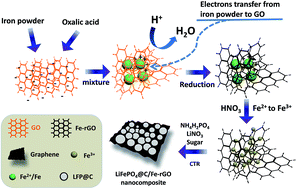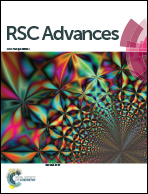Dual roles of iron powder on the synthesis of LiFePO4@C/graphene cathode a nanocomposite for high-performance lithium ion batteries†
Abstract
Robust, conductive, and cost-effective LiFePO4@C/graphene composites are critical in the production of high performance LiFePO4 lithium ion batteries. Herein, a facile method is designed to synthesize LiFePO4@C/graphene nanocomposite by utilizing low-cost iron powder, wherein the iron powder offers dual roles: the raw source for LiFePO4 and the green reductant for graphene oxide (GO). In this proposed process, GO is reduced to reduced graphene oxide (rGO) by the iron powder and the produced iron ions are adsorbed on the surface of rGO. As a precursor of LiFePO4, the adsorbed iron ions facilitate the formation and the strong and uniform anchoring of the LiFePO4 nanoparticles onto the rGO surface. The resultant robust structure could prevent the rGO from restacking, help maintain the integrity of the LiFePO4@C/graphene nanocomposite and afford electronic and ionic conductivity in the rapid charge/discharge process. Consequently, the as-prepared nanocomposite exhibits an excellent high-rate capability and outstanding cycling stability. A discharge capacity of ca. 131 mA h g−1 is obtained at 5C rate and a remarkable cycling stability with capacity retention up to 95% is achieved over 1000 cycles.


 Please wait while we load your content...
Please wait while we load your content...